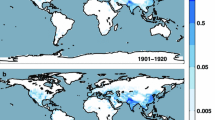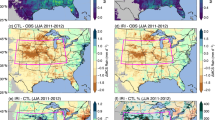Abstract
The impact of land use change on regional climate can be substantial but also is variable in space and time. Past observational and modeling work suggests that in a ‘Mediterranean’ climate such as in California’s Central Valley, the impact of irrigated agriculture can be large in the dry season but negligible in the wet season due to seasonal variation in surface energy partitioning. Here we report further analysis of regional climate model simulations showing that diurnal variation in the impact of irrigated agriculture on climate similarly reflects variation in surface energy partitioning, as well as smaller changes in net radiation. With conversion of natural vegetation to irrigated agriculture, statistically significant decreases of 4–8 K at 2 m occurred at midday June–September, and small decreases of ~1 K occurred in winter months only in relatively dry years. This corresponded to reduced sensible heat flux of 100–350 W m−2 and increased latent heat fluxes of 200–450 W m−2 at the same times and in the same months. We also observed decreases of up to 1,500 m in boundary layer height at midday in summer months, and marginally significant reductions in surface zonal wind speed in July and August at 19:00 PST. The large decrease in daytime temperature due to shifts in energy partitioning overwhelmed any temperature increase related to the reduced zonal sea breeze. Such changes in climate and atmospheric dynamics from conversion to (or away from) irrigated agriculture could have important implications for regional air quality in California’s Central Valley.









Similar content being viewed by others
References
Adegoke JO, Pielke RAS, Eastman JL, Mahmood R, Hubbard KG (2003) Impact of irrigation on midsummer surface fluxes and temperature under dry synoptic conditions: a regional atmospheric model study of the US high plains. Mon Weather Rev 131:556–564
Barnston AG, Schickedanz PT (1984) The effect of irrigation on warm season precipitation in the Southern Great Plains. J Clim Appl Meteorol 23(6):865–888
Bell JL, Sloan LC, Snyder MA (2004) Regional changes in extreme climatic events: a future climate scenario. J Clim 17:81–87
Bonan GB (1997) Effects of land use on the climate of the United States. Clim Change 37(3):449–486
Bonfils C, Lobell D (2007) Empirical evidence for a recent slowdown in irrigation-induced cooling. P Natl Acad Sci USA 104(34):13582–13587
Boucher O, Myhre G, Myhre A (2004) Direct human influence of irrigation on atmospheric water vapor and climate. Clim Dyn 22:597–603
Bounoua L, DeFries R, Collatz GJ, Sellers P, Khan H (2002) Effects of land cover conversion on surface climate. Clim Change 52(1):29–64
Chase TN, Pielke RA, Kittel TGF, Nemani RR, Running SW (2000) Simulated impacts of historical land cover changes on global climate in northern winter. Clim Dyn 16(2–3):93–105
Christy JR, Norris WB, Redmond K, Gallo KP (2006) Methodology and results of calculating Central California surface temperature trends: Evidence of human-induced climate change? J Clim 19(4):548–563
Cooley H, Riley W, Torn M, He Y (2005) Impact of agricultural practice on regional climate in a coupled land surface mesoscale model. J Geophys Res 110(D3):D03113
Dickinson RE, Henderson-Sellers A, Kennedy PJ (1993) Biosphere-atmosphere transfer scheme (BATS) version 1e as coupled to the NCAR Community Climate Model. NCAR, Boulder
Feddema J, Oleson K, Bonan G, Mearns L, Washington W, Meehl G, Nychka D (2005a) A comparison of a GCM response to historical anthropogenic land cover change and model sensitivity to uncertainty in present-day land cover representations. Clim Dyn 25(6):581–609
Feddema JJ, Oleson KW, Bonan GB, Mearns LO, Buja LE, Meehl GA, Washington WM (2005b) The importance of land-cover change in simulating future climates. Science 310(5754):1674–1678
Foley JA, DeFries R, Asner GP, Barford C, Bonan G, Carpenter SR, Chapin FS, Coe MT, Daily GC, Gibbs HK, Helkowski JH, Holloway T, Howard EA, Kucharik CJ, Monfreda C, Patz JA, Prentice IC, Ramankutty N, Snyder PK (2005) Global consequences of land use. Science 309(5734):570–574
Fritsch JM, Chappell CF (1980) Numerical prediction of convectively driven mesoscale pressure systems. 1. Convective parameterization. J Atmos Sci 37(8):1722–1733
Grell GA (1993) Prognostic evaluation of assumptions used by cumulus parameterizations. Mon Weather Rev 121(3):764–787
Holtslag AAM, Boville BA (1993) Local versus nonlocal boundary-layer diffusion in a global climate model. J Clim 6(10):1825–1842
Jacobson MZ (2008) Short-term effects of agriculture on air pollution and climate in California. J Geophys Res. doi:10.1029/2008JD010689
Kanamitsu M, Ebisuzaki W, Woollen J, Yang S-K, Hnilo JJ, Fiorino M, Potter GL (2002) NCEP-DOE AMIP-II Reanalysis (R-2). Bull Am Meteorol Soc 83(11):1631–1643
Kiehl JT, Hack JJ, Bonan GB, Boville BA, Briegleb BP, Williamson DL, Rasch PJ (1996) Description of the NCAR community climate model (CCM33). NCAR, Boulder
Kueppers LM, Snyder MA, Sloan LC (2007) Irrigation cooling effect: regional climate forcing by land-use change. Geophys Res Lett. doi:10.1029/2006GL028679
Kueppers LM, Snyder MA, Sloan LC, Cayan D, Jin J, Kanamaru H, Kanamitsu M, Miller NL, Tyree M, Due H, Weare B (2008) Seasonal temperature responses to land-use change in the Western United States. Global Planet Change 60(3–4):250–264
Lee E, Chase TN, Rajagopalan B, Barry RG, Biggs TW, Lawrence PJ (2009) Effects of irrigation and vegetation activity on early Indian summer monsoon variability. Int J Climatol 29(4):573–581
Lobell D, Bonfils C (2008) The effect of irrigation on regional temperatures: a spatial and temporal analysis of trends in California, 1934–2002. J Clim 21(10):2063–2071
Lobell DB, Bala G, Bonfils C, Duffy PB (2006) Potential bias of model projected greenhouse warming in irrigated regions. Geophys Res Lett. doi:10.1029/2006GL026770
Lobell D, Bala G, Mirin A, Phillips T, Maxwell R, Rotman D (2009) Regional differences in the influence of irrigation on climate. J Clim 22(8):2248–2255
Loveland TR, Reed BC, Brown JF, Ohlen DO, Zhu Z, Yang L, Merchant JW (2000) Development of a global land cover characteristics database and IGBP DISCover from 1 km AVHRR data. Int J Remote Sens 21(6–7):1303–1330
Marshall CH, Pielke RA, Steyaert LT, Willard DA (2004) The impact of anthropogenic land-cover change on the Florida Peninsula Sea breezes and warm season sensible weather. Mon Weather Rev 132(1):28–52
Matthews HD, Weaver AJ, Eby M, Meissner KJ (2003) Radiative forcing of climate by historical land cover change. Geophys Res Lett. doi:10.1029/2002GL016098
Pal JS, Giorgi F, Bi XQ, Elguindi N, Solmon F, Gao XJ, Rauscher SA, Francisco R, Zakey A, Winter J, Ashfaq M, Syed FS, Bell JL, Diffenbaugh NS, Karmacharya J, Konare A, Martinez D, da Rocha RP, Sloan LC, Steiner AL (2007) Regional climate modeling for the developing world—the ICTP RegCM3 and RegCNet. Bull Am Meteorol Soc. doi:10.1175/bams-88-9-1395
Pataki D, McCarthy H, Litvak E, Pincetl S (2011) Transpiration of urban forests in the los angeles metropolitan area. Ecol Appl. doi:10.1890/09-1717.1
Pielke RA, Avissar R, Raupach M, Dolman AJ, Zeng XB, Denning AS (1998) Interactions between the atmosphere and terrestrial ecosystems: influence on weather and climate. Global Change Biol 4(5):461–475
Pielke RA, Liston GE, Eastman JL, Lu LX, Coughenour M (1999) Seasonal weather prediction as an initial value problem. J Geophys Res 104(D16):19463–19479
Pielke RAS, Marland G, Betts RA, Chase TN, Eastman JL, Niles JO, DdS Niyogi, Running SW (2002) The influence of land-use change and landscape dynamics on the climate system: relevance to climate-change policy beyond the radiative effect of greenhouse gases. Philos Trans R Soc Lond Ser A 360:1705–1719
Pielke RA, Adegoke J, Beltran-Przekurat A, Hiemstra CA, Lin J, Nair US, Niyogi D, Nobis TE (2007) An overview of regional land-use and land-cover impacts on rainfall. Tellus B 59(3):587–601
Pouyat RV, Yesilonis ID, Russell-Anelli J, Neerchal NK (2007) Soil chemical and physical properties that differentiate urban land-use and cover types. Soil Sci Soc Am J 71(3):1010–1019
Ramankutty N, Foley JA (1999) Estimating historical changes in global land cover: croplands from 1700 to 1992. Global Biogeochem Cycles 13(4):997–1027
Ramankutty N, Evan AT, Monfreda C, Foley JA (2008) Farming the planet: 1. Geographic distribution of global agricultural lands in the year 2000. Global Biogeochem Cycles. doi:10.1029/2007GB002952
Reynolds RW, Rayner NA, Smith TM, Stokes DC, Wang W (2002) An improved in situ and satellite SST analysis for climate. J Clim 15(13):1609–1625
Sacks W, Cook B, Buenning N, Levis S, Helkowski J (2009) Effects of global irrigation on the near-surface climate. Clim Dyn 33(2):159–175
San Joaquin Valley Air Pollution Control District (2005) Extreme ozone attainment demonstration plan, revised. Fresno
Schoups G, Hopmans JW, Young CA, Vrugt JA, Wallender WW, Tanji KK, Panday S (2005) Sustainability of irrigated agriculture in the San Joaquin Valley, California. P Natl Acad Sci USA. doi:10.1073/pnas.0507723102
Segal M, Pan Z, Turner RW, Takle ES (1998) On the potential impact of irrigated areas in North America on summer rainfall caused by large-scale systems. J Appl Meteorol 37:325–331
Snyder MA, Bell JL, Sloan LC, Duffy PB, Govindasamy B (2002) Climate responses to a doubling of atmospheric carbon dioxide for a climatically vulnerable region. Geophys Res Lett. doi:10.1029/2001GL014431
Snyder PK, Foley JA, Hitchman MH, Delire C (2004) Analyzing the effects of complete tropical forest removal on the regional climate using a detailed three-dimensional energy budget: An application to africa. J Geophys Res. doi:10.1007/s00382-004-0430-0
Sorooshian S, Li J, Hsu K-l, Gao X (2011) How significant is the impact of irrigation on the local hydroclimate in California’s Central Valley? Comparison of model results with ground and remote-sensing data. J Geophys Res. doi:10.1029/2010jd014775
Steiner AL, Tonse S, Cohen RC, Goldstein AH, Harley RA (2006) Influence of future climate and emissions on regional air quality in California. J Geophys Res. doi:10.1029/2005JD006935
Steiner AL, Davis AJ, Sillman S, Owen RC, Michalak AM, Fiore AM (2010) Observed suppression of ozone formation at extremely high temperatures due to chemical and biophysical feedbacks. Proc Natl Acad Sci USA. doi:10.1073/pnas.1008336107
Stohlgren TJ, Chase TN, Pielke RA, Kittel TGF, Baron JS (1998) Evidence that local land use practices influence regional climate, vegetation, and stream flow patterns in adjacent natural areas. Global Change Biol 4(5):495–504
Theobald DM (2005) Landscape patterns of exurban growth in the USA from 1980 to 2020. Ecol Soc 10(1):32
US Environmental Protection Agency (2006) Air quality criteria for ozone and related photochemical oxidants, vol 1. Research Triangle Park, NC
USDA (2004) 2002 census of agriculture. USDA National Agricultural Statistics Service. http://www.nass.usda.gov/census
Zhao M, Pitman AJ (2002) The regional scale impact of land cover change simulated with a climate model. Int J Climatol 22(3):271–290
Zhao C, Andrews AE, Bianco L, Eluszkiewicz J, Hirsch A, MacDonald C, Nehrkorn T, and Fischer ML (2009) Atmospheric inverse estimates of methane emissions from Central California. J Geophys Res. doi:10.1029/2008JD011671
Acknowledgments
We thank M. Tyree for helping generate the potential natural vegetation dataset; L. C. Sloan, W. J. Riley, A. Steiner, and H. Kanamaru for helpful conversations; and two anonymous reviewers for constructive feedback on the manuscript. This study was supported by grants to L. C. Sloan from the California Energy Commission, the National Science Foundation, and the David and Lucile Packard Foundation.
Author information
Authors and Affiliations
Corresponding author
Additional information
L. M. Kueppers, and M. A. Snyder contributed equally to this work.
Rights and permissions
About this article
Cite this article
Kueppers, L.M., Snyder, M.A. Influence of irrigated agriculture on diurnal surface energy and water fluxes, surface climate, and atmospheric circulation in California. Clim Dyn 38, 1017–1029 (2012). https://doi.org/10.1007/s00382-011-1123-0
Received:
Accepted:
Published:
Issue Date:
DOI: https://doi.org/10.1007/s00382-011-1123-0




